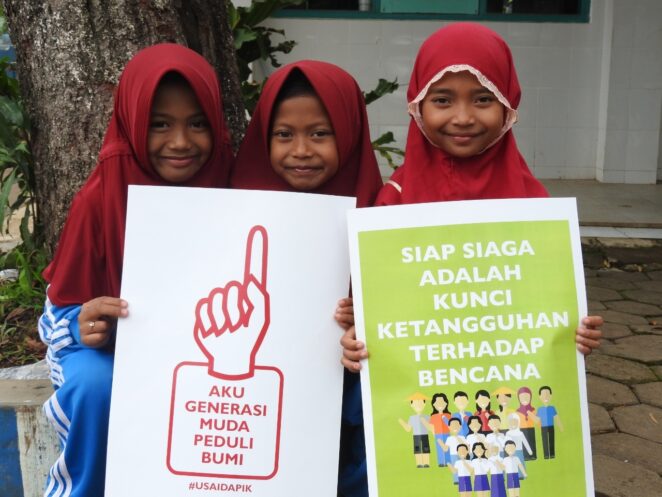Prepare Children to Deal with Disaster and Climate Impacts

This blog post was prepared for National Children Day 2019 and written by Nyoman Prayoga, Communications Specialist: Knowledge Management and Reporting USAID APIK. This is an edited version of the original blog published on the USAID-APIK website on 23 July 2019.
Children are more vulnerable to climate disasters
The threat of climate change to people, particularly children, is growing. UNICEF reports that more than 800 children under 5 years old die every day from diarrhoea due to a lack of water and poor sanitation and hygiene. By 2040, an estimated 600 million children will live with extreme water crises.
According to Indonesia’s National Disaster Management Agency (BNPB), around two-thirds of disaster victims are women, children and the elderly.In 2018 for example, 4,231 lives were lost to disasters in Indonesia, meaning an estimated 2,700 victims were women, children or elderly persons. Further, women and children are at 14 times greater risk to disasters than adult men.
Children are highly vulnerable to and heavily affected by climate change and disasters. Children are typically physically weaker and more psychologically vulnerable than adults, and therefore have different coping and adaptive capacities for preparing for and responding to disasters. The rapid occurrence of disasters, destruction and displacement of homes and the loss or incapacity of family members can be a very traumatic and devastating experience for children. In the context of long-term climate impacts, children are also threatened by disease outbreaks and the disruption of access to resources, such as clean water and food.
Climate and disaster education for children
Building children’s knowledge on climate and disasters is a necessity in Indonesia. A greater understanding is needed in the face of growing threats. The high number of disaster-affected children in recent years shows the urgency of education and capacity building on DRR and resilience for children.
Education efforts are needed at school and in the family setting. Parents need to equip themselves and their children with practical information on what to do to prepare for and cope with disasters, as well as to tackle climate change. Access to knowledge is increasingly open in the digital era, which can help build family knowledge. However, access to digital information and social media limits some households, who must find other sources of information.
Schools play a central role in climate and disaster education. In addition to knowledge, practical activities such as disaster drills and simulations need to be carried out to provide hands-on experience and training. Teachers and school principals must strengthen their own capacity to have a greater understanding of the threats posed by climate change and disasters in their communities.

USAID APIK’s approach
USAID Adaptasi Perubahan Iklim dan Ketangguhan (APIK) realizes the importance of the need to educate children on climate change and disasters. In 2019, USAID APIK supported the Local Disaster Management Agency (BPBD) in three regions, East Java, Southeast Sulawesi, and Maluku, for child-centered campaigns and disaster simulations, as part of the National Disaster Preparedness Day (HKBN), commemorated each year on 26 April. School students in various places such as Kendari City, South Konawe District, Malang District, and Ambon City, gained first-hand experience of evacuations and disaster response activities. Doni Monardo, Head of BNPB, attended the declaration of ‘Protect Nature’ ceremony in Ambon, and planted trees together with hundreds of school students and teachers.
USAID APIK has also facilitated participatory disaster risk assessment at the Madrasah Tsanawiyah Negeri (MTsN – equal with Elementary School) 04 of Siri Sori Islam, Central Maluku, which is vulnerable to flooding, landslides and storms. The risk assessment built awareness of teachers and students on disaster and climate risks and impacts. MTsN 04 Negeri Siri Sori Islam school children helped produce a climate and disaster vulnerability and risk map, and discussed the climate change adaptation actions that could be implemented at the school and in the community.

USAID APIK has also supported the BPBD Malang District to educate on disaster issues at Pujon Elementary School 2 and Kalisongo Elementary School 2 – schools which are prone to landslides. Children participated in simulations, games, and films screenings related to disasters. USAID APIK has raised the importance of evacuation routes and contingency plans for schools in the areas. “I hope this kind of activity can make students living in disaster-prone areas like Malang have the knowledge of disaster risk reduction from an early age,” said Sadono Irawan, Head of the Prevention Section of BPBD Malang District.

Investing in a more resilient future
Children and teachers in participating schools are improving their understanding of disasters and climate change threats in their communities. For example, they are now more familiar with and can use the Meteorology, Climatology and Geophysics Agency (BMKG) products for weather and climate information services. With greater access to climate and disaster knowledge comes greater motivation to include these aspects within their teaching and learning activities.
Knowledge and awareness are at the heart of climate action. Children who are equipped with sufficient knowledge on climate change and disasters can become agents of change in their homes and communities. Educated children share this knowledge with family and friends, helping those who are less familiar with climate and disaster issues. Education empowers children to be more prepared, more resilient, and create opportunities for change in their own futures.
(0) Comments
There is no content